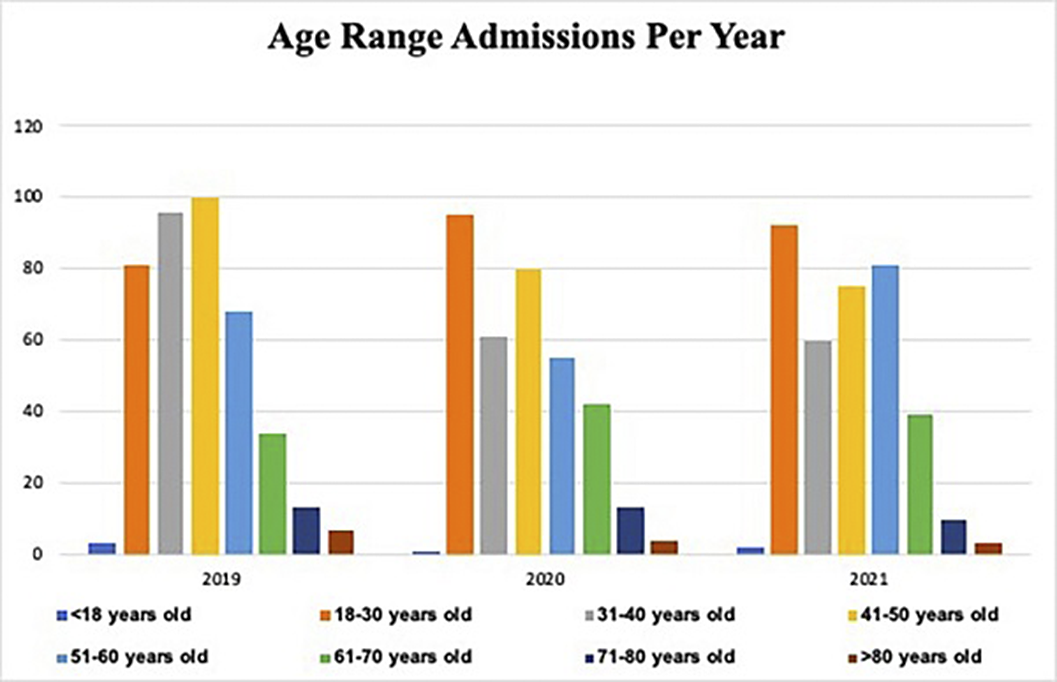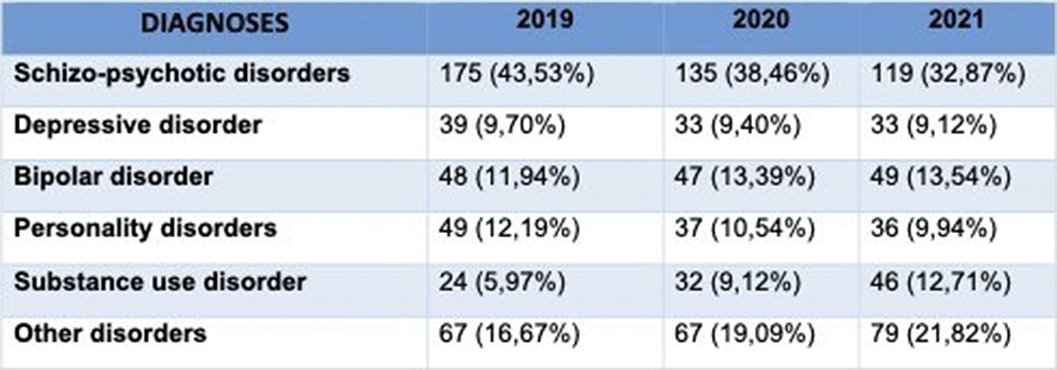147 results
Helminth community structure of the white-bellied woolly mouse opossum Marmosa constantiae Thomas, 1904 in Central-West Brazil
-
- Journal:
- Journal of Helminthology / Volume 97 / 2023
- Published online by Cambridge University Press:
- 21 July 2023, e58
-
- Article
-
- You have access
- Open access
- HTML
- Export citation
How Covid-19 changed psychiatric department admissions: observational study comparison of psychiatric department admissions over three years
-
- Journal:
- European Psychiatry / Volume 66 / Issue S1 / March 2023
- Published online by Cambridge University Press:
- 19 July 2023, pp. S456-S457
-
- Article
-
- You have access
- Open access
- Export citation
Italian validation of Arizona Sexual Experience (ASEX) on patients suffering from psychotic spectrum disorders
-
- Journal:
- European Psychiatry / Volume 65 / Issue S1 / June 2022
- Published online by Cambridge University Press:
- 01 September 2022, p. S117
-
- Article
-
- You have access
- Open access
- Export citation
The role of Effortful Control in Pychopathology Amongst Older Psychiatric Patients
-
- Journal:
- European Psychiatry / Volume 65 / Issue S1 / June 2022
- Published online by Cambridge University Press:
- 01 September 2022, p. S52
-
- Article
-
- You have access
- Open access
- Export citation
Subulura eliseae sp. n. (Ascaridida: Subuluroidea), a parasite of Marmosa spp. from Amazon rainforest, Brazil
-
- Journal:
- Journal of Helminthology / Volume 96 / 2022
- Published online by Cambridge University Press:
- 09 August 2022, e60
-
- Article
-
- You have access
- Open access
- HTML
- Export citation
Adapting group schema therapy for older adults with personality disorders: lessons learnt
-
- Journal:
- The Cognitive Behaviour Therapist / Volume 14 / 2021
- Published online by Cambridge University Press:
- 26 November 2021, e35
-
- Article
-
- You have access
- Open access
- HTML
- Export citation
Suicidality in post-traumatic stress disorder (PTSD) and complex PTSD (CPTSD)
-
- Journal:
- European Psychiatry / Volume 64 / Issue S1 / April 2021
- Published online by Cambridge University Press:
- 13 August 2021, p. S142
-
- Article
-
- You have access
- Open access
- Export citation
Suicidality and relation with dissociation and alexithymia in PNES and conversion disorder
-
- Journal:
- European Psychiatry / Volume 64 / Issue S1 / April 2021
- Published online by Cambridge University Press:
- 13 August 2021, p. S591
-
- Article
-
- You have access
- Open access
- Export citation
Perceived major experiences of discrimination, ethnic group, and risk of psychosis in a six-country case−control study
-
- Journal:
- Psychological Medicine / Volume 52 / Issue 15 / November 2022
- Published online by Cambridge University Press:
- 02 March 2021, pp. 3668-3676
-
- Article
- Export citation
PW01-254 - Risk Factors For Suicide In The Observational Schizophrenia Outpatient Health Outcomes (soho) Study
-
- Journal:
- European Psychiatry / Volume 25 / Issue S1 / 2010
- Published online by Cambridge University Press:
- 17 April 2020, 25-E1661
-
- Article
-
- You have access
- Export citation
Cannabis Abuse at First Episode Psychosis (FEP): Data from Mental Health Centres in Modena and Bologna, Italy
-
- Journal:
- European Psychiatry / Volume 24 / Issue S1 / January 2009
- Published online by Cambridge University Press:
- 16 April 2020, 24-E145
-
- Article
-
- You have access
- Export citation
Institutional Therapeutic Alliance: Empirical, Clinical and Conceptual Remarks
-
- Journal:
- European Psychiatry / Volume 24 / Issue S1 / January 2009
- Published online by Cambridge University Press:
- 16 April 2020, 24-E876
-
- Article
-
- You have access
- Export citation
Individualizing antipsychotic treatment selection in schizophrenia: characteristics of empirically derived patient subgroups
-
- Journal:
- European Psychiatry / Volume 26 / Issue S1 / March 2011
- Published online by Cambridge University Press:
- 16 April 2020, pp. 3-16
-
- Article
- Export citation
Brain structural abnormalities in first episode psychosis: A multimodal analysis
-
- Journal:
- European Psychiatry / Volume 26 / Issue S2 / March 2011
- Published online by Cambridge University Press:
- 16 April 2020, p. 950
-
- Article
-
- You have access
- Export citation
P0208 - Comorbidity of substance abuse and early psychosis in Bologna
-
- Journal:
- European Psychiatry / Volume 23 / Issue S2 / April 2008
- Published online by Cambridge University Press:
- 16 April 2020, p. S142
-
- Article
-
- You have access
- Export citation
Client Satisfaction and Quality Improvement
-
- Journal:
- European Psychiatry / Volume 12 / Issue S2 / 1997
- Published online by Cambridge University Press:
- 16 April 2020, p. 199s
-
- Article
-
- You have access
- Export citation
P0207 - Characteristics of patients at first contact for psychosis in Bologna
-
- Journal:
- European Psychiatry / Volume 23 / Issue S2 / April 2008
- Published online by Cambridge University Press:
- 16 April 2020, pp. S141-S142
-
- Article
-
- You have access
- Export citation
Attitude towards psychiatric patients: a pilot study in a northern Italian town
-
- Journal:
- European Psychiatry / Volume 16 / Issue 8 / December 2001
- Published online by Cambridge University Press:
- 16 April 2020, pp. 451-458
-
- Article
- Export citation
Opioidergic system and N-methyl D-aspartate receptor (NMDA-R) hypofunction: Translational implications for the pathophysiology of psychosis and drug addiction
-
- Journal:
- European Psychiatry / Volume 26 / Issue S2 / March 2011
- Published online by Cambridge University Press:
- 16 April 2020, p. 1231
-
- Article
-
- You have access
- Export citation
Assessing Initial Patient’s Affective Disposition Towards the Hospitalization and the Treatment: A Validation Study
-
- Journal:
- European Psychiatry / Volume 24 / Issue S1 / January 2009
- Published online by Cambridge University Press:
- 16 April 2020, 24-E877
-
- Article
-
- You have access
- Export citation





